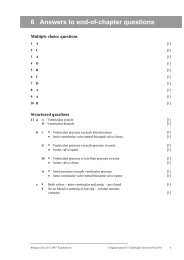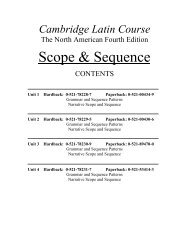Brad Philpot - Cambridge University Press
Brad Philpot - Cambridge University Press
Brad Philpot - Cambridge University Press
You also want an ePaper? Increase the reach of your titles
YUMPU automatically turns print PDFs into web optimized ePapers that Google loves.
Part 3 – Literature: texts and contexts<br />
Free indirect speech is a kind<br />
of limited third-person narration<br />
that allows the reader to hear a<br />
character’s thoughts (see page 181).<br />
142<br />
Key<br />
term<br />
discussion<br />
1 How does the student’s<br />
response differ from your own?<br />
2 What evidence does the<br />
student’s response show of<br />
critical thinking and contextual<br />
understanding?<br />
care of his new boots, softening the leather with grease! Ah, nothing had been so<br />
hard to part with in all his eight years in camps as that pair of boots! They were<br />
tossed into a common heap. Not a hope of finding your own pair in the spring.<br />
1 valenki knee-length felt boots for winter wear<br />
Activity 6.2<br />
Before reading the sample response below, write your own response to Text 6.2, drawing<br />
connections between Solzhenitsyn’s life and One Day in the Life of Ivan Denisovich.<br />
Write about 300–500 words. Remember that your writing must answer the following<br />
question: How do the style and structure of the text reflect the context in which it was written?<br />
One Day in the Life of Ivan Denisovich: style and context<br />
Look at the following response written by a student after reading One Day in the Life of<br />
Ivan Denisovich.<br />
Alexander Solzhenitsyn wrote One Day in the Life of Ivan Denisovich as a work of<br />
historical fiction and most notably not as a memoir or autobiography. He may have<br />
done this for several reasons.<br />
Under the circumstances, Solzhenitsyn was not certain how his personal history<br />
of the gulag would have been received. After being released from prison, he had every<br />
reason to fear imprisonment again for speaking out about the camps. Hiding behind<br />
fictional characters and speaking through the imaginary Ivan Denisovich Shukov was<br />
safer and therefore made sense from the author’s perspective.<br />
Besides this reason, though, there is an even greater reason why Solzhenitsyn<br />
wrote fiction instead of non-fiction. He wanted to be known as an artist, or<br />
novelist, instead of a former prisoner of the gulag. His writing style draws us into<br />
the mind of Shukov through the use of free indirect speech. We see examples of<br />
this when the narrator says, ‘Then in December the valenki arrived, and, oh, wasn’t<br />
life wonderful?’ We feel the elation of the main character for such simple small<br />
things in prison life. Solzhenitsyn goes one step further to make us feel empathy<br />
for Shukov by writing in the second person: Not a hope of finding your own pair in<br />
the spring. This feels like an extreme let-down from the kicking his new heels.<br />
Solzhenitsyn wrote a piece of historical fiction because it allowed him to bring<br />
the gulag to life. He describes everything, from shoes to disease, in such detail<br />
that we feel we are there, experiencing the hardships of this Soviet labour camp.<br />
Sample<br />
As you follow your IB Diploma course and prepare for the Paper 2 exam, you might<br />
find it useful to keep a record of the texts you read. You can use a table such as the one<br />
below to record in summary form what you have read. Not only is this a good exercise<br />
for analysing a text, it will also be a useful overview when you come to revise for your<br />
exam. (You may not be able to fill in the last row of the table just yet. You will be looking<br />
more at the mechanics of fiction and literary devices in Part 4 of this coursebook.<br />
Chapter 7 has more about point of view and narrative technique.)<br />
© <strong>Cambridge</strong> <strong>University</strong> <strong>Press</strong> 2011








